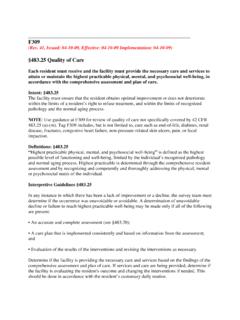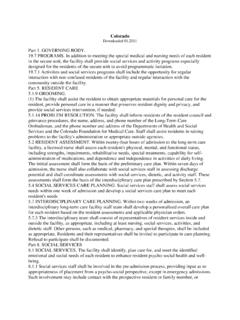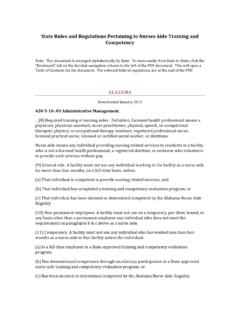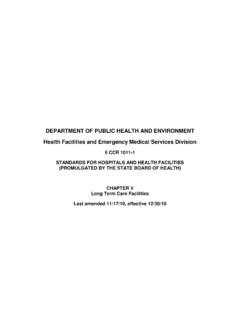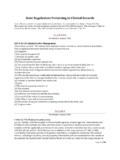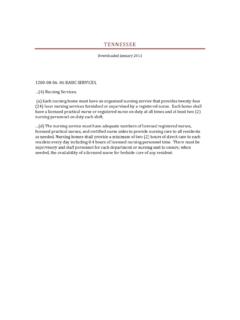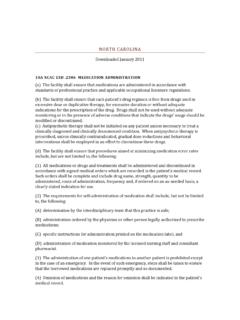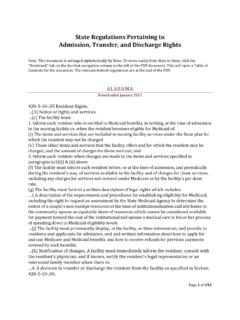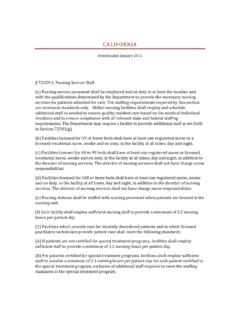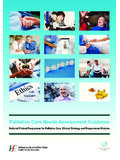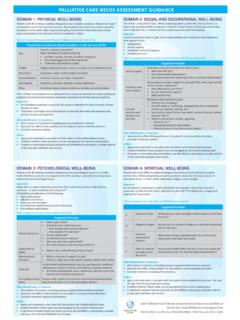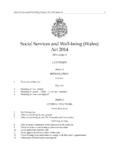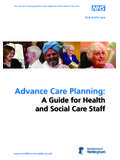Transcription of CHAPTER 4: PROCEDURES FOR COMPLETING THE …
1 CMS s RAI Version Manual CH 4: PROCEDURES for COMPLETING RAPs Revised--December 2002 Page 4-1 CHAPTER 4: PROCEDURES FOR COMPLETING THE resident assessment PROTOCOLS (RAPs) AND LINKING THE assessment TO THE CARE PLAN This CHAPTER provides instructions on how to use the resident assessment Protocols (RAPs) to assess conditions identified by the Minimum Data Set (MDS) triggering mechanism. The goal of the RAPs is to guide the interdisciplinary team through a structured comprehensive assessment of a resident s functional status. Functional status differs from medical or clinical status in that the whole of a person s life is reviewed with the intent of assisting that person to function at his or her highest practicable level of well-being.
2 Going through the RAI process will help staff set resident -specific objectives in order to meet the physical, mental and psychosocial needs of residents. What are the resident assessment Protocols (RAPs)? The MDS alone does not provide a comprehensive assessment . Rather, the MDS is used for preliminary screening to identify potential resident problems, strengths, and preferences. The RAPs are problem-oriented frameworks for additional assessment based on problem identification items (triggered conditions). They form a critical link to decisions about care planning. The RAP Guidelines provide guidance on how to synthesize assessment information within a comprehensive assessment . The Triggers target conditions for additional assessment and review, as warranted by MDS item responses; the RAP Guidelines help facility staff evaluate triggered conditions.
3 There are 18 RAPs in Version of the RAI. The RAPs in the RAI cover the majority of areas that are addressed in a typical nursing facility resident s care plan. The RAPs were created by clinical experts in each of the RAP areas. RAPs are not required for Medicare assessments. RAPs are ONLY required for comprehensive clinical assessments (Admission assessment , Annual assessment , Significant Change in Status assessment (SCSA), or Significant Correction of Prior Full assessment (SCPA). However, when a Medicare assessment is combined with a comprehensive clinical assessment , the RAPs must be completed in order to meet the requirements of the comprehensive clinical assessment . RAPs may also be used any time the facility wishes to provide indepth focused review of any area for which RAPs have been developed.)
4 The care delivery system in a facility is complex yet critical to successful resident care outcomes. It is guided by both professional standards of practice and regulatory requirements. The basis of care assessment Decision-Making Care Plan Care Plan Evaluation (MDS/other) (RAPs/other) Development Implementation CMS s RAI Version Manual CH 4: PROCEDURES for COMPLETING RAPs Revised--December 2002 Page 4-2 delivery is the process of assessment and care planning. Documentation of this process (to ensure continuity of care) is also necessary. The RAI (MDS and RAPs) is an integral part of this process. It ensures that facility staff collects minimum, standardized assessment data for each resident at regular intervals. The main intent is to drive the development of an individualized plan of care based on the identified needs, strengths and preferences of the resident .
5 It is helpful to think of the RAI as a process. The MDS identifies actual or potential problem areas. The RAPs provide further assessment of the triggered areas; they help staff to look for causal or confounding factors (some of which may be reversible). Use the RAPs to analyze assessment findings and then chart your thinking. It is important that the RAP documentation include the causal or unique risk factors for decline or lack of improvement. A risk factor increases the chance of having a negative outcome, or complication. For example, compromised bed mobility increases the risk of a pressure ulcer. In this example, compromised bed mobility is the specific risk factor, and the pressure ulcer is the complication. RAP guidelines may contain cues regarding risk factors and complications associated with the RAP condition.
6 The plan of care then addresses these factors with the goal of promoting the resident s highest practicable level of functioning: 1) improvement where possible, or 2) maintenance and prevention of avoidable declines. RAPs function as decision facilitators, which means they lead to a more thorough understanding of possible problem situations by providing educational insight and structure to the assessment process. The RAPs will give the interdisciplinary team a sound basis for the development of the resident s care plan. After the comprehensive assessment process is completed, the interdisciplinary team will be able to decide if: The resident has a troubling condition that warrants intervention, and if addressing this problem is a necessary condition for other functional problems to be successfully addressed; Improvement of the resident s functioning in one or more areas is possible; Improvement is not likely, but the present level of functioning should be preserved as long as possible, with rates of decline minimized over time; The resident is at risk of decline and efforts should emphasize slowing or minimizing decline, and avoiding functional complications ( , contractures, pain).
7 Or The central issues of care revolve around symptom relief and other palliative measures during the last months of life. OBRA 1987 mandated that facilities provide necessary care and services to help each resident attain or maintain the highest practicable well-being. Facilities must ensure that residents improve when possible and do not deteriorate unless the resident s clinical condition demonstrates that the decline was unavoidable. CMS s RAI Version Manual CH 4: PROCEDURES for COMPLETING RAPs Revised--December 2002 Page 4-3 How are the RAPs Organized? As shown in Appendix C, there are four parts to each RAP: Section I - The Problem gives general information about how a condition affects the nursing facility population. The Problem statement often describes the focus or objectives of the protocol.
8 It is important when reviewing a triggered RAP not to overlook information in the Problem section. Although Section III - The Guidelines contain the detail, the Problem section should be reviewed for information relevant to the assessment . Section II - The Triggers identify one or a combination of MDS item responses specific to a resident that alert the assessor to the resident s possible problems, needs, or strengths. The specific MDS response indicates that clinical factors are present that may or may not represent a condition that should be addressed in the care plan. Triggers merely flag conditions necessary for the interdisciplinary team members to consider in making care planning decisions. When the resident s status on a particular MDS item(s) matches one of the triggers for a RAP, the RAP is triggered and a review (with the possibility of additional data gathering and assessment ) is required using the RAP Guidelines.
9 Section III - The Guidelines present comprehensive information for evaluating factors that may cause, contribute to, or exacerbate the triggered condition. The Guidelines help facility staff decide if a triggered condition actually does limit the resident s functional status or if the resident is at particular risk of developing the condition. If the condition is found to be a problem for the resident , the Guidelines will assist the interdisciplinary team in determining if the problem can be eliminated or reversed, or if special care must be taken to maintain a resident at his or her current level of functioning. In addition to identifying causes or risk factors that contribute to the resident s problem, the Guidelines may assist the interdisciplinary team to: Find associated causes and effects.
10 Sometimes a problem condition ( , falls) is associated with just one specific cause ( , new drug that caused dizziness). More often, a problem ( , falls) stems from a combination of multiple factors ( , new drug, resident forgot walker, bed too high, etc.). Determine if multiple triggered conditions are related. Suggest a need to get more information about a resident s condition from the resident , resident s family, responsible party, attending physician, direct care staff, rehabilitative staff, laboratory and diagnostic tests, consulting psychiatrist, etc. Determine if a resident is a good candidate for rehabilitative interventions. CMS s RAI Version Manual CH 4: PROCEDURES for COMPLETING RAPs Revised--December 2002 Page 4-4 Identify the need for a referral to an expert in an area of resident need.
